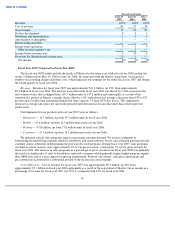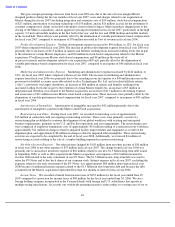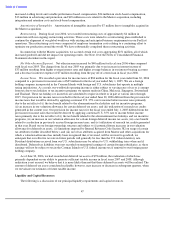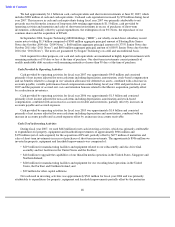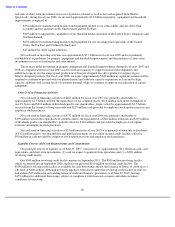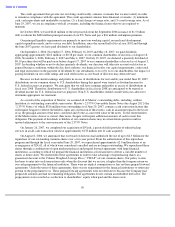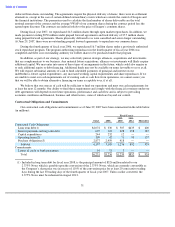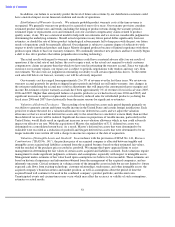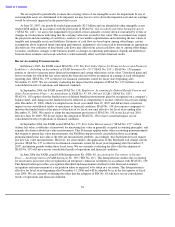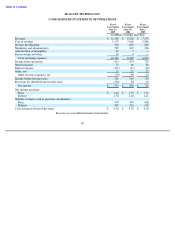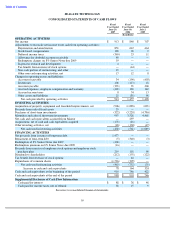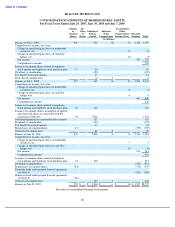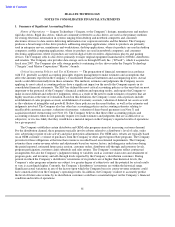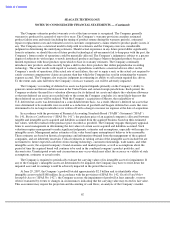Seagate 2006 Annual Report Download - page 56
Download and view the complete annual report
Please find page 56 of the 2006 Seagate annual report below. You can navigate through the pages in the report by either clicking on the pages listed below, or by using the keyword search tool below to find specific information within the annual report.
Table of Contents
In addition, our failure to accurately predict the level of future sales returns by our distribution customers could
have a material impact on our financial condition and results of operations.
Establishment of Warranty Accruals. We estimate probable product warranty costs at the time revenue is
recognized. We generally warrant our products for a period of one to five years. Our warranty provision considers
estimated product failure rates and trends (including the timing of product returns during the warranty periods),
estimated repair or replacement costs and estimated costs for customer compensatory claims related to product
quality issues, if any. We use a statistical model to help with our estimates and we exercise considerable judgment in
determining the underlying estimates. Should actual experience in any future period differ significantly from our
estimates, or should the rate of future product technological advancements fail to keep pace with the past, our future
results of operations could be materially affected. Our judgment is subject to a greater degree of subjectivity with
respect to newly introduced products and legacy Maxtor designed products because of limited experience with those
products upon which to base our warranty estimates. We continually introduce new products and have recently begun
a shift to disc drive products that utilize perpendicular recording technology.
The actual results with regard to warranty expenditures could have a material adverse effect on our results of
operations if the actual rate of unit failure, the cost to repair a unit, or the actual cost required to satisfy customer
compensatory claims are greater than that which we have used in estimating the warranty accrual. Since we typically
outsource our warranty repairs, our repair cost is subject to periodic negotiations with vendors and may vary from
our estimates. We also exercise judgment in estimating our ability to sell certain repaired disc drives. To the extent
such sales fall below our forecast, warranty cost will be adversely impacted.
Our warranty cost has ranged from approximately 2 to 3% of revenue over the last three years. We review our
warranty accrual quarterly for products shipped in prior periods and which are still under warranty. Any changes in
the estimates underlying the accrual may result in adjustments that will impact the current period gross margins and
income. Re-estimates of prior warranty accruals have been approximately 1% of revenue or less in fiscal years 2005,
2006 and 2007. Higher than anticipated failures of specific products (as we had in fiscal years 2004 and 2005) and
significant increases in repair or replacement costs driven by reduced sales for refurbished products (as during the
fiscal years 2006 and 2007) have historically been the major reasons for significant re-estimates.
Valuation of Deferred Tax Assets. The recording of our deferred tax assets each period depends primarily on
our ability to generate current and future taxable income in the United States and certain foreign jurisdictions. Each
period we evaluate the need for a valuation allowance for our deferred tax assets and we adjust the valuation
allowance so that we record net deferred tax assets only to the extent that we conclude it is more likely than not that
these deferred tax assets will be realized. Significant decreases in projections of taxable income, particularly in the
United States, would likely result in significant increases in our valuation allowance which in turn could adversely
impact our effective tax rate. With the acquisition of Maxtor, the realizability of U.S. deferred tax assets was
determined on a consolidated return basis. As a result, Maxtor’s deferred tax assets that were determined to be
realizable were recorded as a reduction of goodwill and Seagate deferred tax assets that were determined to be no
longer realizable were written off with a charge to income tax expense at the date of acquisition.
Valuation of Intangible Assets and Goodwill. In accordance with the provisions of SFAS No. 141, Business
Combinations (“SFAS No. 141”), the purchase price of an acquired company is allocated between tangible and
intangible assets acquired and liabilities assumed from the acquired business based on their estimated fair values,
with the residual of the purchase price recorded as goodwill. We engage third-party appraisal firms to assist
management in determining the fair values of certain assets acquired and liabilities assumed. Such valuations require
management to make significant judgments, estimates and assumptions, especially with respect to intangible assets.
Management makes estimates of fair value based upon assumptions we believe to be reasonable. These estimates are
based on historical experience and information obtained from the management of the acquired companies, and are
inherently uncertain. Critical estimates in valuing certain of the intangible assets include but are not limited to: future
expected cash flows from existing technology, customer relationships, trade names, and other intangible assets; the
acquired company’s brand awareness and market position, as well as assumptions about the period of time the
acquired brand will continue to be used in the combined company’s product portfolio; and discount rates.
Unanticipated events and circumstances may occur which may affect the accuracy or validity of such assumptions,
estimates or actual results.
53


